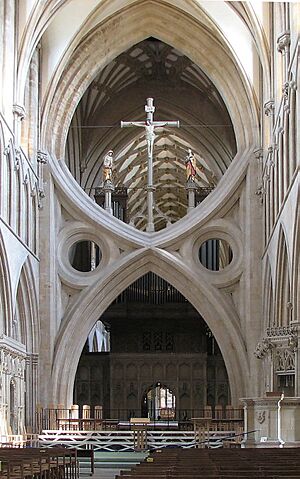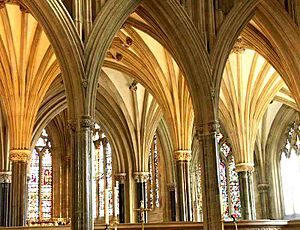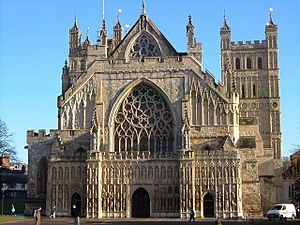William Joy facts for kids
William Joy lived and worked from about 1310 to 1348. He was a very skilled English builder, often called a master mason or architect. He was famous for his work in the Decorated Gothic style, which is a type of church architecture with lots of fancy carvings and detailed windows. Joy helped build several important cathedrals in England. His building style shows he might have learned his skills near Bristol Cathedral.
Contents
Starting His Building Career
William Joy's first known work was around 1310 at the church of St Augustine, which is now Bristol Cathedral. He might have designed a special room there called the Berkeley Chapel sacristy, used for storing church items. After that, he worked at Salisbury Cathedral. There, he created his first "strainer arches." These were special arches designed to stop a tall central tower from falling down.
Wells Cathedral and Clever Arches

William Joy worked with another master builder named Thomas Witney. In 1329, Joy took over Witney's projects at Wells Cathedral. Joy made the choir (the part of the church where singers sit) and the retrochoir (the area behind the main altar) longer. He also designed the beautiful ceiling of the choir.
One of Joy's most famous designs at Wells Cathedral is the "scissor arches." These arches look like giant scissors crossing in the middle. He built them because cracks appeared in the central tower after it was made taller in the 1300s. Many attempts were made to fix the tower, but Joy's clever design not only held it up but also looked like the Saltire Cross, which is the symbol of St Andrew, the saint that Wells Cathedral is named after.
Exeter Cathedral and Its West Front
The Bishop of Exeter, John Grandisson, asked William Joy to build a new church at Ottery St Mary. Then, in 1342, Joy became the head of all building projects at Exeter Cathedral. His first job was to finish designs started by Witney.
Joy designed the amazing screen on the west front (the main entrance) of Exeter Cathedral. This screen originally had two rows of sculptures placed in special carved spaces called canopies. It covered the original arches of the cathedral. The first row had sculptures of 25 angels, and 23 of them are still there today. The second row had spaces for 25 sculptures of kings and knights. Ten of these sculptures, made in the 1340s, can still be seen.
Sadly, work on the cathedral stopped in 1348. This was because of the Black Death, a terrible sickness that spread across Europe just before Christmas. William Joy is not mentioned in any records after this time, so it is thought that he was one of the many people who died from the plague.
Remembering William Joy
William Joy's life and work were recognized in the Oxford Dictionary of National Biography. His entry was published in March 2021, making sure his important contributions to English architecture are remembered.



